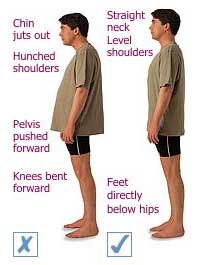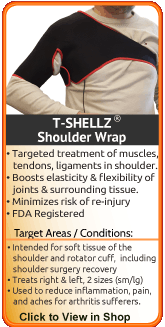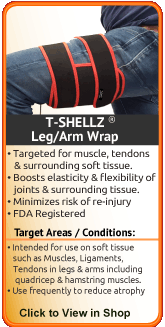Preventing Adhesive Capsulitis/Frozen Shoulder
It is always better to prevent adhesive capsulitis rather than try to fix it after it happens, however that is not always the situation. In any case, there are a number of things you can do to keep yourself healthy and prevent further damage.
Maintain a strong posture
Stand tall and do not slouch as this puts stress on your shoulder joint, neck and upper back muscles. Also, avoid lifting objects that are too heavy for you.
Maintain & Build Your Strength,
Flexibility and Stability
This will stabilize your shoulder and upper arm area, and increase the range of motion in your shoulder, arem and back muscles. Light weights, exercise bands and sticks are very beneficial for strengthening your upper body. Yoga, tai chi, or a daily stretching routine will help to keep your muscles and joints supple.
Maintain a Regular Exercise and Cross Training Program
Focus on total body fitness and include low-impact aerobic activity at least 3 days per week, such as walking, swimming, inline skating or biking. This will help to keep you healthy overall and strengthen your body to prevent against frozen shoulder or other shoulder injuries.
Keep Your Weight Between 18.5 and 25
on the Body Mass Index (Bmi) Scale
Eat a balanced diet of protein, complex carbohydrates, fats, vitamins, minerals, phytochemicals and antioxidants. This will help you support a healthly body and will help you maintain your weight. This is especially important if you have diabetes and need to keep control of your glucose levels. Limiting your caffeine, alcohol and nicotine consumption will also improve your health.
Choose Appropriate Equipment and Supports for your Body Type and Size
Shoulder supports should be used as required during activities (bracing/strapping/taping the area for extra support) but do not wear these when not participating in activities. Mobility aids (long shoe horns, front fastening bras, and/or anything that helps to prevent you from over-reaching) will help alleviate your symptoms and improve functions.
Avoid Doing Too Much Too Soon
Give your body an opportunity to build up its endurance, and to protect your soft tissues from injury and overuse. This is especially important when participating in a new activity. Gradually increase your participation to prevent overstraining your shoulder muscles and joint.
Always Warm Up Your Muscles
Warm up your muscles before exercise(especially your shoulder, arm and back muscles) to prepare your body and raise your body temperature.
Always Cool Down Your Muscles
Recover from your exercise by doing a cool down routine to lower your body temperature and relax your muscles.
Use proper form and techniques
Learn the correct body positions for your activity to help prevent injuries.
Listen to your Body
If you are suffering from shoulder pain and/or stiffness, listen to your body and decrease, modify and/or avoid any activities or motions that cause pain and irritation such as repetitive lifting, pushing, pulling, throwing, and/or overhead movements. If you are required to perform these motions at work or play and cannot avoid them, make sure you take frequent breaks and rest to prevent fatigue and pain. It is important not to rush your recovery to prevent further damage.
Product Advisors are available 9:00 am to 5:00 pm Eastern Standard Time Monday to Friday.
Living with pain is never easy and we encourage you to call us with any questions you have related to your frozen shoulder. We will do our best to help.
Learn More About Shoulder Injuries & TreatmentsI want to learn more about Frozen Shoulder Causes. I want to learn more about TShellz Wrap® Circulatory Boost I want to learn more about Ice & Heat: Which Is Better For Treatment? I want to learn more about Trigger Points. I want to learn more about Frozen Shoulder Manipulation. I want to learn more about Post Surgery Recovery?
FREE SHIPPING ON ALL PRODUCTS CURRENTLY ENABLED
60 DAY TRIAL PERIOD
During your recovery, you will probably have to modify and/or eliminate any activities that cause pain or discomfort at the location of your soft tissue injury until the pain and inflammation settle. The more diligent you are with your treatment and rehabilitation, the faster you will see successful results!
| 



